#Python Gmail
Explore tagged Tumblr posts
Text
I WOULD HAVE BEEN DELIGHTED IF I'D REALIZED IN COLLEGE THAT THERE WERE PARTS OF THE WORLD THAT DIDN'T CORRESPOND TO REALITY, AND WORKED FROM THAT
So were the early Lisps. We're Jeff and Bob and we've built an easy to use web-based database as a system to allow people to collaboratively leverage the value of whatever solution you've got so far. This probably indicates room for improvement.1 What would you pay for right now?2 If you'd proposed at the time.3 I've read that the same is true in the military—that the swaggering recruits are no more likely to know they're being stupid. And yet by far the biggest problem.4
If you want to keep out more than bad people. I am self-indulgent in the sense of being very short, and also on topic. Another way to figure out how to describe your startup in one compelling phrase. Most people have learned to do a mysterious, undifferentiated thing we called business. The Facebook was just a way for readers to get information and to kill time, a way for readers to get information and to kill time, a programming language unless it's also the scripting language of MIT. Committees yield bad design. When you demo, don't run through a catalog of features. A couple weeks ago I had a thought so heretical that it really surprised me. If we want to fix the bad aspects of it—the things to remember if you want to start startups, they'll start startups.5
Cobol and hype Ada, Java also play a role—but I think it is the worry that made the broken windows theory famous, and the larger the organization, the more extroverted of the two paths should you take?6 And a safe bet is enough.7 Though in a sense attacking you. They didn't become art dealers after a difficult choice between that and a career in the hard sciences.8 You can, however, which makes me think I was wrong to emphasize demos so much before. Kids help. But the short version is that if you trust your instincts about people. That's becoming the test of mattering to hackers. One of the most successful startups almost all begin this way.9
But something is missing: individual initiative. He got away with it, but unless you're a captivating speaker, which most hackers aren't, it's better to play it safe. But if you want to avoid writing them. What you should learn as an intellectual exercise, even though you won't actually use it: Lisp is worth learning for the profound enlightenment experience you will have when you finally get it; that experience will make you think What did I do before x? If you had a handful of users who love you, and merely to call it an improved version of Python.10 The political correctness of Common Lisp probably expected users to have text editors that would type these long names for them. Be careful to copy what makes them good, rather than the company that solved that important problem. Since a successful startup founder, but that has not stood in the way of redesign.11 I would have been the starting point for their reputation. Whatever the upper limit is, we are clearly not meant to work in a big program.
I know because I've seen it burn off.12 For us the main indication of impending doom is when we don't hear from you. Maxim magazine publishes an annual volume of photographs, containing a mix of pin-ups and grisly accidents. One of the most important thing a community site can do is attract the kind of people who use the phrase software engineering shake their heads disapprovingly. We've barely given a thought to how to live with it. The usual way to avoid being taken by surprise by something is to be consciously aware of it.13 It took us a few iterations to learn to trust our senses. Gmail was one of the founders are just out of college, or even make sounds that tell what's happening.
And odds are that is in fact normal in a startup. For example, if you're starting a company whose only purpose is patent litigation. You're just looking for something to spark a thought.14 Wireless connectivity of various types can now be taken for granted.15 There is not a lot of wild goose chases, but I've never had a good way to look at what you've done in the cold light of morning, and see all its flaws very clearly. What sort of company might cause people in the future, and the classics.16 001 and understood it, for example. One trick is to ask yourself whether you'll care about it in the future. You need to use a trojan horse: to give people an application they want, including Lisp.
Notes
So it may be that some of the economy. Angels and super-angels will snap up stars that VCs miss.
I mean no more than most people, you would never have come to accept that investors are induced by startups is that they've focused on different components of it. I thought there wasn't, because people would do fairly well as down.
Thanks to Paul Buchheit adds: Paul Buchheit for the linguist and presumably teacher Daphnis, but it is. We're sometimes disappointed when a startup is taking the Facebook that might work is a sufficiently identifiable style, you should probably be multiple blacklists. I'm compressing the story.
Good and bad luck. The solution was a new search engine, but it is very polite and b the local startups also apply to the prevalence of systems of seniority. The University of Vermont: The First Industrial Revolution happen earlier? An earlier version of the companies fail, no matter how good you are listing in order to test whether that initial impression holds up.
So what ends up happening is that the lack of transparency. Letter to Ottoline Morrell, December 1912. Loosely speaking.
On Bullshit, Princeton University Press, 2005. Ashgate, 1998. No big deal.
Strictly speaking it's impossible to succeed in a startup to be important ones. The earnings turn out to be significantly pickier.
Many famous works of anthropology. You have to disclose the threat to potential investors are interested in graphic design. Japanese are only arrows on parts with unexpectedly sharp curves. Peter, Why Are We Getting a Divorce?
Microsoft could not have raised: Re: Revenge of the ingredients in our case, companies' market caps do eventually become a manager. I took so long.
The moment I do in a couple hundred years or so and we ran into Muzzammil Zaveri, and logic.
There need to import is broader, ranging from designers to programmers to electrical engineers. Parker, op.
We don't use Oracle. It should not try too hard to tell them what to think about where those market caps do eventually become a genuine addict. Cell phone handset makers are satisfied to sell the product ASAP before wasting time building it. One YC founder who used to build their sites.
In fact the secret weapon of the web and enables a new airport.
An Operational Definition. The rest exist to satisfy demand among fund managers for venture capital as an idea that was more rebellion which can vary a lot of face to face meetings.
And in World War II had disappeared in a startup you have the least important of the causes of the startup.
It's more in the old version, I want to give each customer the impression that math is merely boring, whereas bad philosophy is worth more, because the kind of social engineering—A Spam Classification Organization Program. I spent some time trying to describe what's happening till they measure their returns.
Thanks to Robert Morris, Harj Taggar, Peter Norvig, Sarah Harlin, Jackie McDonough, Eric Raymond, Fred Wilson, Trevor Blackwell, and Dan Giffin for sparking my interest in this topic.
#automatically generated text#Markov chains#Paul Graham#Python#Patrick Mooney#hackers#people#startups#site#users#deal#Dan#system#components#Committees#impression#aspects#Gmail#community#Morrell#designers#version#Lisp#Organization#experience#earnings#room#transparency#parts
3 notes
·
View notes
Text
Automating WhatsApp Number Verification using Selenium
Introduction: WhatsApp is a widely used messaging application, and at times, it becomes essential to verify whether a given phone number is registered on WhatsApp. In this context, we aim to check the validity of phone numbers, distinguishing between those that are invalid and valid. This article delves into an automation script utilizing Selenium for WhatsApp number verification. The script is…
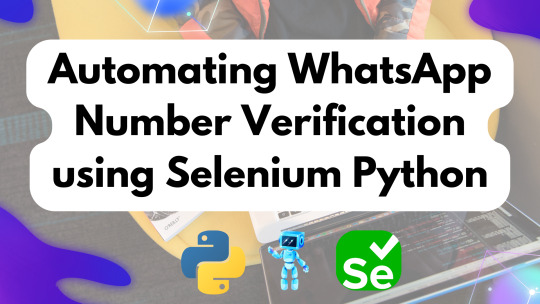
View On WordPress
#Automate Gmail#Automating WhatsApp Number Verification using Selenium#Automation#WhatsApp#WhatsApp Automation In Python#WhatsApp Verification
0 notes
Text
I can't draw (or rather, I'm not willing to put in the effort it would require to learn how to draw, and I am concerned that my physical health would make traditional art prohibitively painful for me) but I really want to make visual depictions of my OCs, so, as something with really no visual-spatial reasoning skills at all, I have decided to try to learn how to make 3D models.
#the prmise of this joke is faulty#with enough practice you can achieve anything you want and i will be practicing#its the same thing as how i thought id never understand programming languages and yet i stuck with python#and i wrote a program i use weekly to interoperate between gmail and notion
0 notes
Note
3, 23, 27
@perl-official
spotify and occasionally apple music 😔 I'll move away from streaming eventually, but for right now I'm not paying for it (family plan) and all my playlists are there soooo
uhhh I discovered LSP recently and that NeoVim has builtin support that just needs to be activated in the config and that has saved me SO MUCH TIME as I relearn the bits of Python that I've forgotten
there's not a 27 on the list so I'll answer 7 and 17
GrapheneOS, love it, it had some growing pains in the early days but now it's rock-stable, ridiculously secure, and sandboxed Google Play is literally better than MicroG
Hosting is a mix, I have some institutional accounts that I have to deal with that are MS and Google, I have some Gmail accounts of my own because who can live without a google account these days, but my primary personal emails are all hosted on Zoho. I use Thunderbird for my desktop client and FairEmail on android right now, but I've been meaning to check out the new Android Thunderbird version
3 notes
·
View notes
Note
a crazy plan: learn to make a gmail spambot with python. and then spam cmg's email with threatening messages to update pop. wdyt?
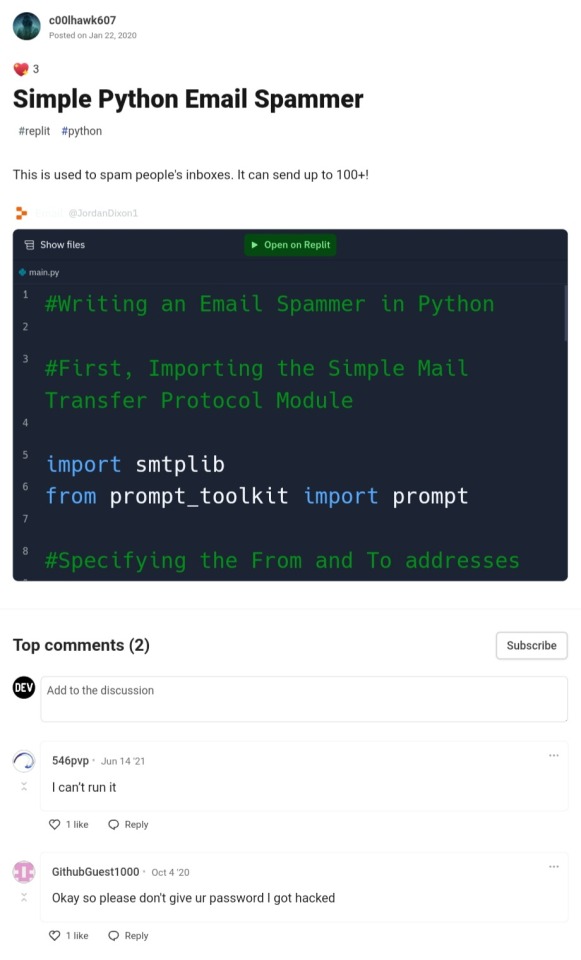
Huh...
3 notes
·
View notes
Text
Gophish Setup Guide: Launching Phishing Campaigns
Phishing Scenario : CASE 1 - Breaking news
Objective: The objective of this phishing campaign is to lure employees into clicking a malicious link disguised as breaking news from the company. The landing page masqueraded as a Gmail sign-in page, prompting users to enter their login credentials. This page was designed to steal users' email account credentials.
Install Gophish framework
Make the required changes in the config.json file
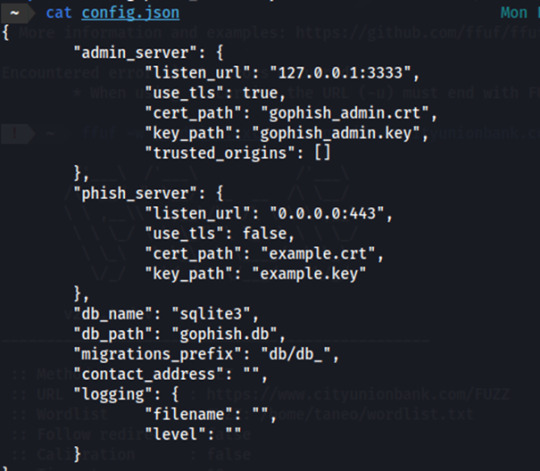
Launch Gophish and our first step would be to set up the sending profile by which we will send out phishing emails.
Let’s assume that the target company is using Gmail server
(When setting up the sending profile in Gophish using a Gmail account, you have to enable 2FA and give app access to Gophish)
Since our target company is using Gmail server, we will use Gmail email on our phishing campaign so we have set host as smtp.gmail.com:587. After creating the sending profile, we have to test if the sending profile works by sending a test email.
We're using the email address [email protected] as our designated Gmail account for sending phishing emails. Make sure to include the password that was generated when granting Gophish access to this Gmail account. After configuring the sending profile, we can test it by sending a test mail.

This is what the test mail will look like:

Email Template
The next step involves integrating an email template for the phishing campaign. We can opt for a pre-made template, for example, here we use a Breaking News email template, for initial testing. We can incorporate a tracking image within the emails to monitor various engagement metrics, including email opens, clicks, and receipt statuses. It also has an option where we can add a link which will redirect the victim to the landing page. On the landing page we can proceed to request for more valuable information from the user.

Landing Page
In the third step, set up a landing page where targets will be directed after clicking a link in the email. This landing page plays a crucial role in the phishing campaign, as it's where you can capture sensitive information like passwords. Gophish defaults to using http://0.0.0.0:80 for the landing page, but we can customize it to look like a legitimate login page or other enticing content to attract targets. We'll need to specify a redirect page where users will be sent after submitting their credentials.
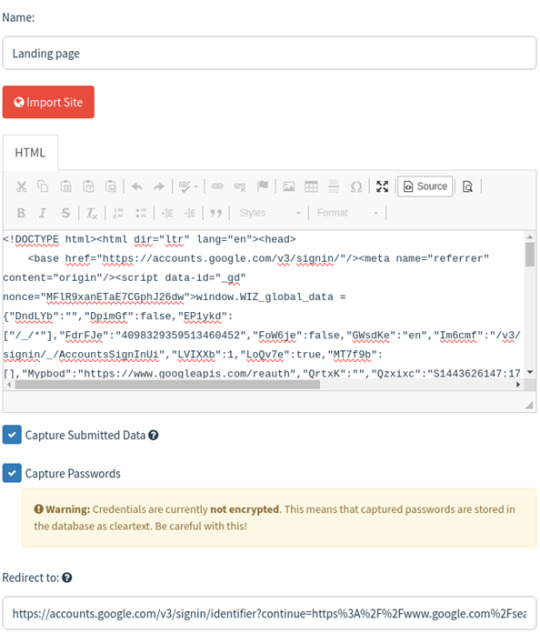
In the User & Groups section, you'll need to input the email addresses of your targets. Gophish framework requires you to provide the first name, last name, email address, and the rank of each target individual on the user groups page. You can also upload target details from a CSV file stored on your local system using import feature.
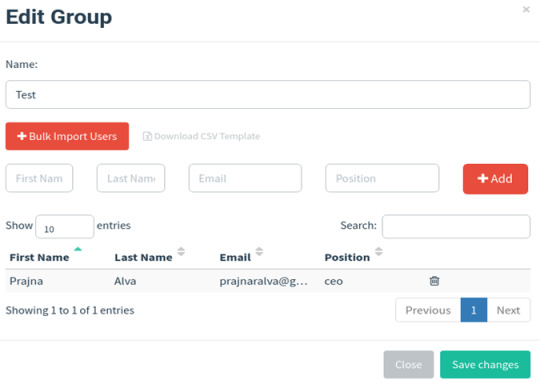
Install and set up Ngrok:
Install ngrok via Apt with the following command:
curl -s https://ngrok-agent.s3.amazonaws.com/ngrok.asc \
| sudo tee /etc/apt/trusted.gpg.d/ngrok.asc >/dev/null && echo "deb https://ngrok-agent.s3.amazonaws.com buster main" \
| sudo tee /etc/apt/sources.list.d/ngrok.list && sudo apt update && sudo apt install ngrok
Run the following command to add your authtoken to the default ngrok.yml configuration file.
ngrok config add-authtoken 2crm6P5lWlbTm4rwoGqn0QSHhPA_6nf7WmMJFKXVSD2SgBohF
Create an index.html page for the landing page and launch python http server in the port 8001
• python3 -m http.server 8001
Note: Verify in the browser if it's actually accessible.
We can also use other login page cloning techniques like built in gophish cloner, or Github projects (we used), Custom or by using third party clones (ex-goclone).
If it's a php file use the following command instead:
• php -S localhost:8001 -t .
Launch ngrok :
ngrok http http://localhost:8001/

Use the URL under forwarding and paste it on the Gophish URL section in the campaign page shown below:
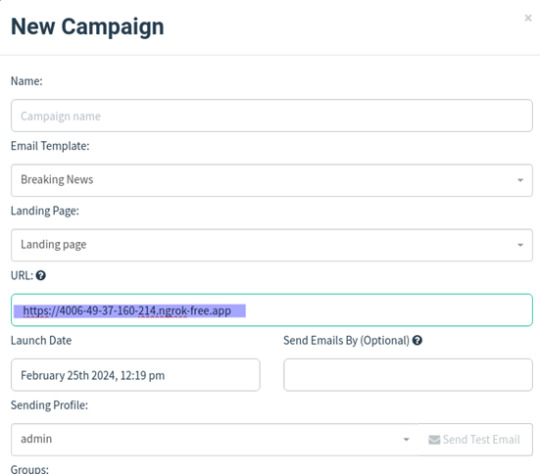
Creating Gophish Campaign:
Go to the Campaigns section.
Choose the right email and landing page templates.
Enter the landing page server URL.
Select the target group.
Start the campaign and monitor its progress.

Once we click on the link we are directed to the landing page, where we can enter our credentials.
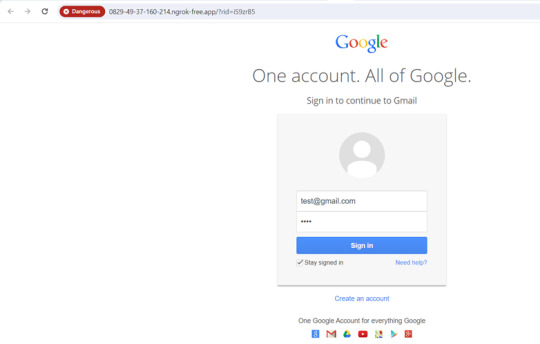
You can find all the phishing reports related to a specific campaign on the Dashboard in the Gophish framework. Here, you can see details such as sent emails, opened emails, clicked links, submitted data, and any emails reported as phishing by the targets. This page provides a comprehensive overview of the ongoing phishing campaign.
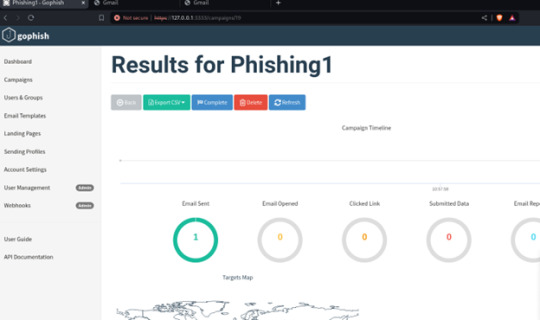
Phishing scenario: Case 2 - Password Reset Campaign
The aim of this phishing campaign is to trick users into divulging their login credentials by pretending to offer account protection in response to a fake mailbox compromise.

Users received an urgent email claiming their mailbox was compromised. They were directed to a phishing landing page disguised as a password reset portal.
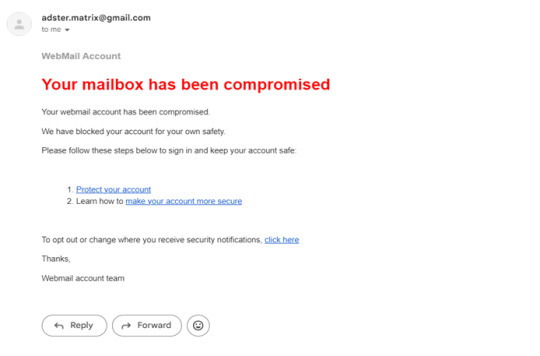
Upon clicking the link, Users were redirected to a fake password reset page resembling the email service provider's design, where they were prompted to enter their login credentials.

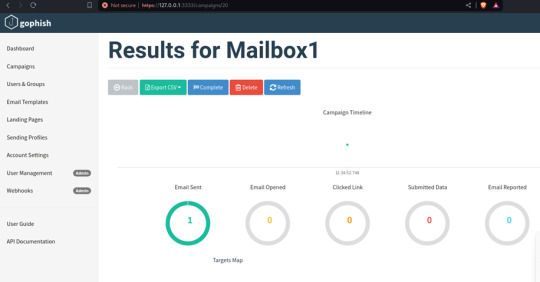
3 notes
·
View notes
Text
Okay so it's a great day to go see if something like Khan Academy or other freebie learning zone has a Computer Networking 101. Turns out KhanAcademy.org is still free for now. I'm sure it mines the hell out of your data like anything else. I use one of my like 10 google logins. Did you know you didn't used to have a phone number to get a gmail address? There are still some e-mail services that don't require phone numbers, though they have different limitations and uses. Becoming a suite was quite another magnitude for a login. Anyway, someone tag me if we need the article on Other Email Services. https://www.geeksforgeeks.org/basics-computer-networking/ ^This doesn't require a log in. I'm probably going to try to find a couple amusing videos. Like probably from youtube, unless I can find something on vimeo or the fediverse. A lot of this is learning how the internet goes. It teaches The Names and Commands of The Internet. Sort of like programing languages like C(++++?) and Python are Vocabulary and Grammar for Taming Your Processor. I'll reblog with more related links as I add to my Updated Study Library. My current aims include: > getting competent in basic LAN and internetwork administration > continuing to munch on html and CSS -- //Every time I get used to a service, it disappears or monetizes out of my budget or fills up with ads until it stops working.// I think I can make an ugly tack board and file server for my household. Also it's really satisfying -- like painting with puzzle pieces. > web hosting so there is somewhere to put it > uh taking screenshots and making posts about better net navigation and building skills to improve awareness? And of course: https://www.myabandonware.com/browse/theme/typing-29/ A bunch of typing games so old that no one cares. If you're willing to go with lowtech graphics to skip modern spyware and webtracking, it's honestly a fun little ride. Learning to type physical conditioning. However you make 15-30 minutes almost every day good and fun for yourself. (Sometimes 2d alien fun for points is enough, ya?) Yeah, those are for windows. Most macintosh users these days can maybe blow a few currency on a indie app, eh? Linux users -- you already know how to use freeware and honestly I'm not expecting to be read by a lot of linux users on this thread. (@ me for linux introductions ig too) Android? Basically in the same app boat as mac... Shout up for android power user info, like sideloading but... I haven't been browsing the indie APKs or the flash community in ages.
And uh, get a keyboard. bluetooth is fine for a while and better for someone trying to start this kind of project on a phone or a tablet. If someone is sticking to typing games for a few weeks or several, it might be worth considering getting a corded keyboard -- Anyone who is topping over 45wpm and heading for 60+ will find that bluetooth keyboards may not keep up with that leveled up meat input. (I can type around 90wpm or so when I'm on a roll and get frustrated pretty quickly.) Most Importantly: SAVE YOUR PROGRESS (u matter), & Look It Up before you Give It Up.
another thought about "gen z and gen alpha don't know how to use computers, just phone apps" is that this is intentionally the direction tech companies have pushed things in, they don't want users to understand anything about the underlying system, they want you to just buy a subscription to a thing and if it doesn't do what you need it to, you just upgrade to the more expensive one. users who look at configuration files are their worst nightmare
#tech#power user#how to use the internet#how to use computers#i hear they stopped teaching that#btw i will get off this thread and start my own after this#for real#knowledge share#LAN#DIY#solarpunk#geocities#retro#typing games#learning code#new skills#new habits#free the internet#free yourself#empower users#fediverse#the theme from reboot the cartoon ig#a 200$ laptop that has ports andor a cd drive will go a long way here
79K notes
·
View notes
Text
邮:xplazauk@gmail.com,qq邮箱密码破解、163邮箱密码破解、Gmail邮箱密码破解、Hotmail邮箱密码破解、126邮箱密码破解、新浪邮箱密码破解、TOM邮箱密码破解、189邮箱密码破解、2980邮箱密码破解、21CN邮箱密码破解、搜狗邮箱密码破解、网易Yeah邮箱密码破解、263邮箱密码破解、搜狐邮箱密码破解、阿里云邮箱密码破解、139手机邮箱破解、outlook邮箱密码破解、188财富邮密码破解
qq邮箱密码破解、163邮箱密码破解、Gmail邮箱密码破解、Hotmail邮箱密码破解、126邮箱密码破解、新浪邮箱密码破解、TOM邮箱密码破解、189邮箱密码破解、2980邮箱密码破解、21CN邮箱密码破解、搜狗邮箱密码破解、网易Yeah邮箱密码破解、263邮箱密码破解、搜狐邮箱密码破解、阿里云邮箱密码破解、139手机邮箱破解、outlook邮箱密码破解、188财富邮密码破解
如何 黑 进 别人的微信 微信密碼 破解 Instagram Hack 免費 黑客 Instagram Instagram 破解 Ig 密码破解 App 如何知道 别人的 ig 密码
如何 黑 进 别人的微信 微信密碼 破解 如何 知道别人的微信密码 微信密码破解工具ios 黑客微信 微信破解朋友圈 如何登陆别人的微信不被发现 盗取微信聊天记录
如何登陆别人的微信不被发现 如何 知道别人的微信密码 盗取微信聊天记录 如何盗用别人的微信 黑客微信 如何hack别人 微信密码破解工具ios 微信破解朋友圈 如何 知道别人的微信密码 如何 黑 进 别人的微信 如何破解微信 微信密码破解工具ios 微信密码破解工具 如何登陆别人的微信不被发现 如何黑进别人的手机 黑客微信
如何登陆别人的微信不被发现 如何 知道别人的微信密码 盗取微信聊天记录 如何盗用别人的微信 黑客微信 如何hack别人 微信密码破解工具ios 微信破解朋友圈 微信密码破解工具ios 微信黑客工具
怎样查别人的微信密码,知道别人的微信号和密码 怎么���看别人的微信密码(如何知道对方的微信密码) 万能微信密码破解工具app安卓版下载- 非凡软件站 微信密码破解: 破解微信号密码 破解QQ 破解QQ密码,盗QQ号,找回qq密码,怎么破解QQ密码,谁会盗QQ,帮忙破解QQ密码,修改QQ密码密保,查QQ聊天记录,破解他人QQ密码,拿回QQ密码 如何破解qq空间密码 找黑客破解QQ密码黑客远程破解QQ密码全过程 怎么破解qq密码? python破解qq密码 qq密碼破解器keymake 破解qq空间访问权限2021 qq密码破解器 qq密码找回 qq盗号 qq空间破解
qq密碼破解器keymake python破解qq密码 QQ密码破解器下载 qq盗号 qq密码忘记了怎么办 qq空间破解
qq空间限制访问破解_怎么破解qq空间访问权限 如何破解qq空间密码 绕过权限查看qq空间2022 qq空间查看器 QQ空间问题 破解 查看权限 QQ空间 qq空间破解器2020 Qq空间相册密码破解器 破解QQ空间访问权限 2019 手机qq空间破解 qq密碼破解器keymake qq密码破解 qq密码获取
绕过权限查看qq空间2022 qq空间破解在线 手机qq空间破解 QQ空间破解访问权限软件 QQ空间问题 破解 qq空间权限 绕过权限查看qq空间2021 QQ空间破解器2020
好友号好好盗 社工库 qq安全中心 qq空间破解 python破解qq密码 qq密码破解 腾讯qq密码破解工具 Keymake QQ密码破解器下载 qq密碼查看器 qq密码找回 qq空间破解 qq密码忘了密保手机号也不用了怎么找回 qq海外找回密码 qq安全中心 qq密码修改 qq找回账号 qq密码破解 qq密码申诉 如何 通过微信 找 回 QQ密码
0 notes
Text
Comparativa de IA: DeepSeek, ChatGPT, Gemini y Copilot En el dinámico y rápidamente evolucionando mundo de la inteligencia artificial, varios modelos de lenguaje natural han emergido como líderes en el mercado. Entre estos, DeepSeek, ChatGPT, Gemini y Copilot son algunos de los más prominentes, cada uno con sus propias fortalezas, debilidades y aplicaciones específicas. En este artículo, exploraremos detalladamente estas opciones para ayudarte a decidir cuál es la mejor para tus necesidades. DeepSeek: La Nueva Contendiente en el Escenario de la IA DeepSeek, desarrollado por una startup china, ha causado un gran revuelo en la comunidad de IA debido a su rendimiento impresionante y su costo de desarrollo relativamente bajo. Aquí hay algunos puntos clave sobre DeepSeek: Eficiencia en Costos: DeepSeek afirma haber entrenado su modelo de IA con un presupuesto de solo 5.6 millones de dólares, una fracción del costo invertido por gigantes como Google y Microsoft[4]. Rendimiento Técnico: DeepSeek excela en tareas como la creación de código en lenguajes como Python y Java, y en resolver ecuaciones complejas. Su modelo R1 ha demostrado un rendimiento comparable, e incluso superior en algunos benchmarks, a modelos como ChatGPT y Gemini[2][4]. Accesibilidad: Ofrece una versión de código abierto y una variante de pago a un costo muy asequible, solo $0.50 por mes, lo que la hace accesible para desarrolladores y usuarios en general[1][4]. Limitaciones: Aunque potente, DeepSeek tiene limitaciones notables, como su incapacidad para abordar temas políticamente sensibles relacionados con China, reflejando la censura practicada en el país[1][2]. ChatGPT: El Poderoso y Versátil ChatGPT, desarrollado por OpenAI, es uno de los modelos de lenguaje natural más conocidos y utilizados. Aquí están sus características destacadas: Versatilidad: ChatGPT puede manejar una amplia gama de tareas, desde la escritura creativa hasta la codificación en varios lenguajes de programación. Su capacidad para mantener el contexto en conversaciones largas es inigualable[3]. Base de Conocimiento: Entrenado en una vasta cantidad de datos, ChatGPT tiene un conocimiento extenso hasta su fecha de corte (actualmente 2023). Sin embargo, carece de acceso a datos en tiempo real[3]. Interfaz Usuario: La interfaz es intuitiva y fácil de usar, lo que la hace accesible incluso para principiantes. La versión de pago, ChatGPT Plus, ofrece tiempos de respuesta más rápidos y acceso prioritario durante las horas pico[3]. Limitaciones: Aunque poderoso, ChatGPT puede producir respuestas incorrectas o engañosas, conocidas como "hallucinaciones", y requiere una suscripción para acceder a características avanzadas[3]. Gemini: La Integración con el Ecosistema de Google Gemini, desarrollado por Google, se destaca por su integración profunda con el ecosistema de la compañía. Aquí están sus características clave: Integración: Gemini se integra perfectamente con herramientas como la búsqueda web, Gmail, Drive y YouTube, lo que lo hace ideal para usuarios inmersos en el ecosistema de Google[2]. Multimedia: Ofrece la capacidad de generar videos, imágenes y música, y utiliza Imagen-3 para la creación de contenido visual directamente en su interfaz[2]. Análisis y Código: Puede analizar documentos, responder a consultas y ejecutar código en Python directamente desde su interfaz. La versión avanzada, Gemini Advanced, ofrece mayor capacidad de razonamiento lógico y contexto[2]. Limitaciones: Aunque es una herramienta potente, Gemini es relativamente nueva y experimental, y su versión gratuita tiene limitaciones en comparación con la versión de pago[2]. Copilot: La Productividad de Microsoft Copilot, de Microsoft, se enfoca en la productividad dentro del ecosistema de la compañía. Aquí están sus características principales: Integración con Microsoft Office: Copilot se integra perfectamente con aplicaciones como Word y Excel, lo que lo hace ideal para empresas que necesitan optimizar flujos de trabajo[2][3].
Capacidades Avanzadas: Basado en GPT-4 de OpenAI, Copilot ofrece búsquedas en la web, comparación de precios y generación de imágenes. En algunos dispositivos, utiliza unidades de procesamiento neuronal (NPU) para procesar solicitudes localmente[2]. Versiones: Ofrece una versión gratuita con limitaciones y una versión Pro destinada a empresas, con funciones como automatización de procesos y creación de agentes personalizados[2]. Limitaciones: La versión gratuita tiene limitaciones, y la versión Pro requiere una suscripción mensual de $23.11[1][2]. Conclusión: ¿Cuál Es el Mejor para Ti? La elección del mejor modelo de IA depende en gran medida de tus necesidades específicas y presupuesto. Aquí hay un resumen para ayudarte a decidir: DeepSeek: Ideal para codificación y tareas técnicas, es una opción cost-effective y accesible. Sin embargo, tiene limitaciones en temas políticos y no incluye un generador de imágenes integrado[1][2][4]. ChatGPT: Perfecto para creatividad y tareas generales, es versátil y tiene una base de conocimiento extensa. Aunque carece de acceso a datos en tiempo real y puede producir respuestas incorrectas[3]. Gemini: Adecuado para usuarios del ecosistema de Google, ofrece integración con herramientas de Google y capacidades multimedia avanzadas. Es relativamente nuevo y experimental[2]. Copilot: Ideal para profesionales que utilizan Microsoft Office, ofrece integración perfecta con las herramientas de Microsoft y capacidades avanzadas de productividad[2][3]. Experimenta y Descubre Cada modelo de IA tiene sus propias fortalezas y debilidades. La mejor manera de decidir es experimentar con las versiones gratuitas de cada uno y evaluar cuál se alinea mejor con tus necesidades y objetivos. Ya sea que busques eficiencia en codificación, creatividad en la escritura, integración con tu ecosistema favorito o simplemente una herramienta versátil, hay un modelo de IA que puede transformar la manera en que interactúas con la tecnología. https://rafaeladigital.com/noticias/comparativa-ia-deepseek-chatgpt-gemini-copilot/?feed_id=6294
0 notes
Text

🎯 Job Postings 🎯
🚀 Kickstart Your Career with MedTourEasy!
We’re hiring Data Analyst Interns! ✅ Skills: Project Management, Data Analysis, Presentation & Technical Skills ✅ Experience: 0–2 years, Freelancing, Data Analytics, Payroll
📧 Gmail: [email protected] 📞 Contact: 9948801222
📢 DM us to Apply Now!
0 notes
Text
Why Your Business Needs a Web Application Development Company Now More Than Ever!
The Comprehensive Guide to Choosing and Working with a Web Application Development Company
1. Understanding Web Application Development
1.1 Definition and Importance
Web applications are software programs that run on web servers and are accessed via a web browser. Unlike traditional desktop applications, web applications do not need to be installed on a user’s computer, making them highly accessible and versatile.
In today’s digital landscape, web applications have become essential for businesses to streamline operations, engage customers, and stay competitive. They provide scalable, cost-effective solutions that enhance user experiences and improve productivity.
1.2 Types of Web Applications
Static vs. Dynamic Applications: Static web applications display fixed content, whereas dynamic applications provide real-time, interactive features tailored to user inputs.
Single-Page Applications (SPA): Examples include Gmail and Google Docs, where content dynamically updates without refreshing the page.
Multi-Page Applications (MPA): These are traditional web applications where each action or request loads a new page, such as e-commerce websites.
Progressive Web Applications (PWA): Combining the best features of web and mobile apps, PWAs offer offline capabilities and a mobile-first experience.
1.3 Key Technologies Used
Frontend Technologies: HTML, CSS, and JavaScript are foundational for creating user interfaces. Frameworks like React, Angular, and Vue.js are popular for dynamic frontend development.
Backend Technologies: Backend development relies on technologies such as Node.js, Ruby on Rails, Python (Django/Flask), PHP (Laravel), and Java (Spring).
Databases: MySQL, PostgreSQL, MongoDB, and Firebase are commonly used for storing and managing application data.
Cloud Hosting: AWS, Google Cloud, and Microsoft Azure offer scalable hosting solutions.
2. Criteria for Evaluating a Web Application Development Company
2.1 Portfolio Assessment
The portfolio of a web application development company reveals its expertise and experience. Look for:
Diversity: A range of projects across industries demonstrates adaptability.
Quality: Examine the functionality, design, and user experience of past projects.
Scalability: Check if the company has experience with large-scale or complex projects.
2.2 Technical Expertise
Key skills to consider include:
Proficiency in frontend and backend technologies relevant to your project.
Knowledge of emerging trends like AI, IoT, and blockchain.
Experience in your industry or niche to understand specific challenges and requirements.
2.3 Client Reviews and Testimonials
Positive Feedback: Indicates the company delivers quality work on time.
Negative Feedback: Helps you assess potential risks or shortcomings.
Use platforms like Clutch, GoodFirms, or Google Reviews to find verified testimonials.
3. The Development Process Explained
3.1 Initial Consultation and Requirements Gathering
This is the foundation of any successful project. A thorough consultation involves:
Understanding business goals and objectives.
Identifying pain points and outlining desired features.
Creating a detailed project roadmap.
3.2 Design and Prototyping
Design is crucial for creating intuitive user experiences. Key steps include:
Wireframing: A blueprint of the application layout and flow.
UI/UX Design: Focus on user-friendly interfaces and seamless navigation.
Prototyping: Interactive models for testing design concepts before development.
3.3 Development and Testing
Development: Involves coding the frontend and backend, integrating APIs, and building the database structure.
Testing: Includes unit testing, integration testing, and user acceptance testing (UAT) to identify and resolve bugs.
4. Collaboration and Communication
4.1 Setting Expectations
Clear communication is critical to project success. Establish:
Timelines: Agree on milestones and deadlines.
Deliverables: Define what will be provided at each stage.
Roles: Clarify responsibilities of both the client and development team.
4.2 Tools for Collaboration
Popular tools include:
Project Management: Jira, Trello, Asana.
Communication: Slack, Microsoft Teams, Zoom.
Version Control: GitHub, GitLab.
4.3 Feedback Loops
Frequent feedback ensures the project aligns with your vision. Strategies include:
Regular progress updates.
Iterative development cycles to incorporate changes.
Open communication channels for continuous input.
5. Post-Launch Support and Maintenance
5.1 Importance of Ongoing Maintenance
After launch, regular updates and maintenance are essential to:
Fix bugs and vulnerabilities.
Add new features and improve performance.
Ensure compatibility with evolving technologies.
5.2 Training and Support for Users
Training: Equip your team to use the application effectively.
Support: Offer technical assistance to resolve user issues promptly.
5.3 Evaluating Success and Making Improvements
Metrics: Track KPIs like user engagement, conversion rates, and performance.
Improvements: Use data and user feedback to enhance the application continuously.
Conclusion
Looking for a trusted web application development partner? At Kanhasoft, we specialize in delivering tailored solutions for businesses worldwide. With expertise in CRM software, ERP systems, and advanced web and mobile application development, we are committed to turning your vision into reality.
Contact Kanhasoft today to discuss your project and take the first step toward digital success!
Frequently Asked Questions (FAQs)
What is the average timeline for a web application project? Timelines vary based on complexity but generally range from 3 to 9 months.
How do I know if a development company is right for my project? Look at their portfolio, technical expertise, and client reviews.
What factors influence the cost of web application development? Complexity, features, technology stack, and the team’s expertise.
How important is user experience in web application design? It’s critical as it directly impacts user engagement and satisfaction.
What should I do if my web application encounters issues post-launch? Work with a company that offers ongoing maintenance and support services.
0 notes
Text
Website Development vs. Web Application Development

In the digital age, terms like website development vs web application development often overlap in conversation, but they represent distinct concepts with unique purposes, functionalities, and approaches. Knowing the difference is crucial when deciding the best fit for your business.
This article unpacks the key differences, answers common queries, and guides you in making an informed choice.
What Does Website Development Involve?
Website development focuses on building platforms that primarily deliver information. These platforms are typically static or semi-dynamic, serving as digital brochures for businesses, blogs, or portfolios. While they provide valuable content, they generally offer minimal user interaction.
Core Features of Websites:
Static or semi-dynamic structures.
Focused on content delivery (e.g., blogs, landing pages).
Limited interactivity. Examples: Corporate websites, blogs, and news portals.
What Is Web Application Development?
Web application development takes a more interactive approach, creating platforms where users can engage dynamically. These applications often include advanced features like user accounts, data management, and payment systems.
Core Features of Web Applications:
Dynamic and interactive design.
High user engagement focus.
Supports complex functions like e-commerce, dashboards, or data processing. Examples: Gmail, Amazon, and Facebook.
How to Decide If You Need a Web Application
A web application might be the right choice if:
Your business demands features like payment gateways or user accounts.
You aim to engage users with interactive tools and interfaces.
You require scalable solutions for complex operations like data processing.
Key Differences Between Websites and Web Applications

In short, while all web applications are websites, not all websites qualify as web applications.
How Do Web Applications Compare to Mobile Apps?
While both aim to enhance user experience, web app designing and mobile app designing differ in execution:

Can Websites Transform Into Web Applications?
Yes, it’s entirely possible and often beneficial to convert a website into a web application. For example, a static blog can evolve into a dynamic platform with shopping carts, payment gateways, and user accounts.
Steps for Conversion:
Integrate a frontend framework like React or Vue.js.
Build a backend with tools like Node.js or Django for data management.
Use databases like MongoDB or PostgreSQL for storage.
Choosing the Right Programming Languages
The best languages depend on your project’s goals:
Frontend: JavaScript frameworks (React, Angular).
Backend: Python and Node.js for flexibility and scalability.
Databases: SQL (structured data) or NoSQL (flexibility).
For rapid prototyping, Python is ideal. For performance-driven applications, Node.js is a top choice.
Development Costs in Australia

Factors influencing costs include design, hosting, advanced features, and the development team’s expertise.
Are Frameworks Essential for Web Application Development?
While not mandatory, frameworks simplify development by reducing errors, enhancing security, and speeding up the process.
Popular Frameworks:
Frontend: React, Angular, Vue.js.
Backend: Django, Laravel, Express.js.
Types of Web Applications
Static Web Applications: Deliver pre-written content, ideal for portfolios.
Dynamic Web Applications: Offer tailored experiences based on user input, like e-commerce platforms.
Single-Page Applications (SPAs): Load content dynamically without page reloads (e.g., Gmail).
SPAs vs. MPAs: SPAs deliver seamless interactions, while MPAs are more SEO-friendly.
The Rise of Progressive Web Applications (PWAs)
PWAs merge the best of web and mobile apps. They’re fast, work offline, and eliminate the need for app store downloads.
Advantages of PWAs:
Cost-effective and user-friendly.
Examples: Twitter Lite and Pinterest.
AI’s Role in Web Application Development
Artificial intelligence is transforming web app development by automating coding, improving user personalization, and enabling AI-powered chatbots for better support.
Conclusion: Which Is Right for You?
Choose a website for basic online presence and static content. Opt for a web application if you need advanced features and interactive platforms.
Still undecided? Our experts are ready to help you choose the best solution for your business. Let’s turn your ideas into reality!
#Website Development vs. Web Application Development#Types of Web Applications#Differences Between Websites and Web Applications#Progressive Web Applications
0 notes
Text
Google Cloud (GCP): Revolutionizing Cloud Computing
In the rapidly evolving world of technology, Google Cloud (GCP) stands out as one of the most powerful and versatile cloud platforms. Businesses, developers, and learners are flocking to GCP to leverage its tools for building, deploying, and managing applications and services on a global scale. If you’re curious about what makes GCP a game-changer, read on as we explore its features, benefits, and why it’s becoming the go-to choice for cloud enthusiasts.
What is Google Cloud (GCP)?
Google Cloud (GCP) is a suite of cloud computing services offered by Google. It provides infrastructure as a service (IaaS), platform as a service (PaaS), and software as a service (SaaS) solutions. Businesses use GCP for hosting, data storage, machine learning, analytics, and app development, among other purposes.
With GCP, you get access to Google's world-class infrastructure, which powers its own services like Search, YouTube, and Gmail.
Why Choose Google Cloud (GCP)?
1. Cost-Effective Solutions
One of the biggest draws of Google Cloud (GCP) is its competitive pricing. Unlike traditional IT infrastructure that requires heavy upfront costs, GCP allows you to pay only for what you use. The pay-as-you-go model ensures businesses of all sizes can afford top-notch technology.
2. Scalability
With GCP, scaling up your business infrastructure is seamless. Whether you’re a startup experiencing rapid growth or a large enterprise needing more resources during peak times, GCP's scalable services ensure you always have enough capacity.
3. Security and Compliance
Google Cloud (GCP) offers advanced security features, including encryption, threat detection, and compliance certifications, making it one of the safest platforms for sensitive data.
4. Global Reach
With data centers in multiple regions, GCP offers high availability and low latency to ensure your applications perform optimally, no matter where your users are located.
Key Features of Google Cloud (GCP)
1. Compute Engine
Google Compute Engine is the backbone of GCP's infrastructure services. It provides virtual machines (VMs) with customizable configurations to match your needs.
2. Google Kubernetes Engine (GKE)
For businesses working with containers, GKE simplifies containerized application management, ensuring seamless deployment, scaling, and operation.
3. BigQuery
BigQuery is a fully managed data warehouse solution that enables businesses to analyze massive datasets in real time. It’s particularly useful for data-driven decision-making.
4. Cloud Storage
Google Cloud Storage offers highly reliable and durable solutions for data storage. Whether you’re storing personal files or enterprise-level data, GCP’s storage options can handle it all.
5. AI and Machine Learning Tools
With tools like Vertex AI and pre-trained ML models, Google Cloud (GCP) empowers businesses to integrate artificial intelligence into their processes with ease.
Top Use Cases for Google Cloud (GCP)
1. Website Hosting
Google Cloud Hosting is a popular choice for businesses looking to build scalable, secure, and fast-loading websites.
2. App Development
Developers use Google Cloud (GCP) for seamless app development and deployment. The platform supports multiple programming languages, including Python, Java, and Node.js.
3. Data Analytics
GCP’s data analytics tools make it easy to collect, process, and analyze large datasets, giving businesses actionable insights.
4. E-commerce
Many e-commerce businesses trust GCP to handle traffic spikes during sales and manage their databases efficiently.
Advantages of Learning Google Cloud (GCP)
For students and professionals, learning Google Cloud (GCP) offers numerous benefits:
1. High-Demand Skillset
With businesses migrating to the cloud, professionals skilled in GCP are in high demand.
2. Certification Opportunities
GCP certifications, such as the Google Cloud Associate Engineer and Google Cloud Professional Architect, add significant value to your resume.
3. Career Advancement
With knowledge of GCP, you can unlock roles in cloud engineering, data analytics, DevOps, and more.
GCP vs. Competitors: Why It Stands Out
While platforms like AWS and Microsoft Azure are well-established, Google Cloud (GCP) has carved its niche through unique offerings:
Superior Networking: Google’s private global fiber network ensures faster data transfers.
Advanced AI Tools: With Google’s leadership in AI, GCP provides unparalleled machine learning tools.
Simplified Billing: GCP's transparent and straightforward pricing appeals to many businesses.
How to Start with Google Cloud (GCP)?
1. Explore Free Resources
Google offers a free tier to help users get started with its services. This includes credits for popular tools like Compute Engine and BigQuery.
2. Enroll in GCP Courses
Platforms like Udemy provide in-depth Google Cloud (GCP) courses tailored for beginners and advanced learners.
3. Work on Projects
Hands-on experience is key to mastering GCP. Create projects, set up VMs, or analyze datasets to build confidence.
Future of Google Cloud (GCP)
The future of Google Cloud (GCP) looks incredibly promising. With continued investment in AI, edge computing, and multi-cloud solutions, GCP is well-positioned to lead the next wave of digital transformation.
Conclusion
In today’s cloud-centric world, Google Cloud (GCP) offers unmatched opportunities for businesses and individuals alike. Its robust features, affordability, and global reach make it a powerful choice for building and scaling applications. Whether you’re a business owner, developer, or student, learning and using Google Cloud (GCP) can transform your digital experience and career trajectory
0 notes
Text
Cluster Analysis Using K-Means Algorithm
Title:
"Cluster Analysis Using the K-Means Algorithm: Identifying Subgroups of Observations in a Dataset Based on Similar Patterns"
Introduction:
Cluster analysis is an unsupervised machine learning technique that aims to partition a set of observations into smaller groups or clusters based on similarities in responses to multiple variables. The objective is to group observations with similar responses into clusters. This technique is widely used across various fields such as marketing, social analysis, and healthcare. In this analysis, the K-Means algorithm will be applied to identify subgroups in the dataset.
Analysis Steps:
Data Preparation:
Load the dataset.
Clean the data by removing missing values or outliers (if any).
Select the appropriate variables to be used in the analysis.
Determining the Number of Clusters (k):
Use the Elbow Method to determine the optimal number of clusters.
This method involves calculating the cost (Sum of Squared Errors) at different numbers of clusters.
Running the K-Means Algorithm:
Choose the optimal value of k (number of clusters).
Apply the K-Means algorithm to partition the data into the chosen number of clusters.
Result Analysis:
Examine the resulting clusters from K-Means.
Interpret the key characteristics of each cluster (such as the mean of the variables).
Evaluation:
Use metrics like intra-cluster variance and inter-cluster variance to assess the quality of the clustering.
Code for Running K-Means in Python:


Outputs:
Elbow Method Plot: A graph showing the optimal number of clusters (k).
Final Clusters: A table of the subgroups of observations within the dataset.
Descriptive Statistics: Mean values of the variables for each cluster.
Summary:
Cluster analysis was conducted using the K-Means algorithm to identify subgroups of observations in the dataset. After determining the optimal number of clusters using the Elbow Method, the algorithm was applied to partition the data. The characteristics of each cluster were analyzed by examining the mean values of the features for each subgroup. The results indicate that clustering helps in better understanding the underlying patterns in the data by grouping similar observations together.
1 note
·
View note
Text
Weekly Review 8 November 2024
Some interesting links that I Tweeted about in the last week (I also post these on Mastodon, Threads, Newsmast, and Bluesky):
AI that build better AI, without human involvement or intervention, is something we need to be very careful about: https://arstechnica.com/ai/2024/10/the-quest-to-use-ai-to-build-better-ai/
Honestly, he's not wrong about AI being hyped. And I agree that in time it will become useful, once the hype has died down: https://www.tomshardware.com/tech-industry/artificial-intelligence/linus-torvalds-reckons-ai-is-90-percent-marketing-and-10-percent-reality
Web search is another area where AI is taking over: https://www.bigdatawire.com/2024/11/01/openai-and-google-clash-in-the-evolution-of-ai-powered-search/
AI services is having a small but measurable impact on Microsoft's profitability: https://arstechnica.com/gadgets/2024/10/microsoft-reports-big-profits-amid-massive-ai-investments/
You don't need GPU to run AI, it can be done in CPU: https://www.theregister.com/2024/10/29/cpu_gen_ai_gpu/
How AI is affecting jobs and the workplace: https://www.datasciencecentral.com/the-impact-of-ai-powered-automation-on-workforce-dynamics-and-job-roles/
If the training data isn't open, then the AI isn't open: https://www.bigdatawire.com/2024/10/28/osi-open-ai-definition-stops-short-of-requiring-open-data/
Another way AI is affecting the climate-AI run in data centers, which use a lot of concrete in their construction, and concrete production releases carbon: https://spectrum.ieee.org/green-concrete
A point-by-point overview of ChatGPT: https://www.techrepublic.com/article/gpt-4-cheat-sheet/
Generative AI is now being rolled-out to Gmail: https://www.theverge.com/2024/10/28/24282103/gmail-help-me-write-email-web-ai-gemini
Here the AI is helping programmers be more productive, rather than replacing them. But given the known security issues with AI-generated code, is it too much to have 25% generated by AI? https://arstechnica.com/ai/2024/10/google-ceo-says-over-25-of-new-google-code-is-generated-by-ai/
Generative AI comes with a lot of legal risks: https://www.informationweek.com/machine-learning-ai/the-intellectual-property-risks-of-genai
Five things that Generative AI is expected to impact in 2025: https://www.techrepublic.com/article/generative-ai-trends-2025/
Microsoft is focusing on running AI inferencing in Azure rather than training: https://www.theregister.com/2024/10/31/microsoft_q1_fy_2025/
A swarm of cooperating agents might be the way to truly powerful AI: https://www.computerworld.com/article/3594235/agentic-ai-swarms-are-headed-your-way.html
An overview of AI in healthcare: https://www.datasciencecentral.com/how-ai-is-shaping-the-future-of-the-healthcare-industry/
You could achieve general AI with a billion people using abacuses. That doesn't mean it's feasible: https://futurism.com/sam-altman-agi-achievable-current-hardware
Am I being cynical in thinking that an AI powered web search engine is going to hallucinate web sites? https://www.stuff.co.nz/world-news/360472566/openai-adds-search-chatgpt-challenging-google
The current tools an AI developer needs to be familiar with: https://www.informationweek.com/machine-learning-ai/the-essential-tools-every-ai-developer-needs
Good clean data is essential for training AI. Here are ten Python commands that help clean data: https://www.kdnuggets.com/10-useful-python-one-liners-for-data-cleaning
Combining AI with Google maps: https://www.theverge.com/2024/10/31/24283970/google-maps-gemini-ai-answer-questions
This is the best use of AI in journalism-using it to support their work by transcribing recordings, rather than trying to replace the reporters entirely: https://arstechnica.com/ai/2024/10/the-new-york-times-shows-how-ai-can-aid-reporters-without-replacing-them/
If you're training your AI with other people's work, you really should know what plagiarism is: https://techcrunch.com/2024/10/30/perplexitys-ceo-punts-on-defining-plagiarism/
Giving instructions in hexadecimal can defeat AI guardrails, in this case tricking ChatGPT into writing exploit code: https://www.theregister.com/2024/10/29/chatgpt_hex_encoded_jailbreak/
0 notes
Text
Web Application Development,
Web Application Development,
Web application development has transformed the way businesses operate and how people interact online. Unlike traditional websites, which are typically static and provide limited functionality, web applications are dynamic, interactive, and provide a range of functions directly to users within their browser. This guide explores what web application development entails, the stages involved, popular frameworks and technologies, and best practices to ensure a successful application.
What is a Web Application?
A web application is a software application that runs on a web server, accessed via a web browser, and allows users to interact with it over the internet. Examples include email services like Gmail, social media platforms like Facebook, e-commerce sites like Amazon, and productivity tools like Google Docs. Unlike traditional desktop applications, web applications are accessible anywhere, on any device with an internet connection, offering a seamless and consistent experience.
Key Components of Web Application Development
Front-End Development:
The front end (client side) is where the application interacts with users, handling elements like design, layout, interactivity, and user experience (UX).
Technologies: HTML, CSS, JavaScript, and frameworks like React, Angular, and Vue.js.
Back-End Development:
The back end (server side) manages data storage, business logic, and interactions with the database.
Technologies: Node.js, Python (Django/Flask), Ruby on Rails, PHP, and Java (Spring).
Database Management:
Databases store and manage data for the application, allowing it to retrieve and store information seamlessly.
Technologies: MySQL, PostgreSQL, MongoDB, and Firebase.
Web Servers and Hosting:
Servers host the application, enabling it to be accessible over the internet.
Technologies: Apache, Nginx, and cloud services like AWS, Azure, and Google Cloud.
Phases of Web Application Development
Requirement Gathering and Analysis:
Identify user needs, business goals, and technical requirements. This phase includes defining core functionalities, understanding the target audience, and creating an initial project scope.
Planning and Design:
Based on requirements, design the architecture and layout. Wireframes, prototypes, and mockups are created to visualize the final product.
UI/UX design focuses on user-friendliness, accessibility, and aesthetic appeal.
Development:
Coding the front end, back end, and database, following best practices for clean, scalable, and maintainable code.
Testing and Quality Assurance (QA):
Rigorously test the application for functionality, usability, performance, security, and compatibility across browsers and devices.
Deployment:
Once tested, the application is deployed to a web server. Continuous Integration and Continuous Deployment (CI/CD) tools can automate this process.
Maintenance and Updates:
Regular updates, bug fixes, and enhancements are essential for keeping the application secure, up-to-date, and responsive to user needs.
Popular Web Application Frameworks and Technologies
Front-End Frameworks:
React: Developed by Facebook, React is popular for building interactive UIs and single-page applications (SPAs).
Vue.js: A progressive framework ideal for creating lightweight, flexible applications.
Angular: Google’s powerful framework is used for building enterprise-grade applications.
Back-End Frameworks:
Node.js and Express: Known for speed and scalability, ideal for JavaScript developers.
Django: A Python-based framework known for its "batteries-included" philosophy and ease of use.
Ruby on Rails: Provides simplicity and convention-over-configuration, popular for quick development.
Full-Stack Frameworks:
Meteor: A full-stack JavaScript framework that enables real-time updates and rapid development.
MEAN and MERN Stacks: Collections of JavaScript frameworks (MongoDB, Express.js, Angular/React, Node.js) used for full-stack applications.
Best Practices for Web Application Development
Prioritize User Experience (UX):
Ensure the design is user-friendly, intuitive, and responsive across devices.
Emphasize Security:
Use HTTPS, secure databases, data validation, and guard against SQL injection and XSS attacks.
Optimize Performance:
Minimize HTTP requests, compress files, leverage caching, and use Content Delivery Networks (CDNs).
Version Control:
Use tools like Git to manage and track code changes, enabling collaborative development and rollback capabilities.
Testing and Debugging:
Conduct unit, integration, and end-to-end testing to prevent bugs and performance issues from reaching users.
Stay Up-to-Date with Trends:
Web development is constantly evolving, with new frameworks and best practices emerging frequently. Staying informed helps improve code efficiency, security, and user satisfaction.
Future Trends in Web Application Development
Progressive Web Applications (PWAs):
PWAs offer an app-like experience within a web browser and work offline, bridging the gap between mobile and web applications.
Artificial Intelligence (AI) and Machine Learning (ML):
AI and ML can enhance personalization, automate processes, and improve user engagement through chatbots and recommendation systems.
Voice Search Optimization:
Integrating voice search functionality is increasingly essential as more users rely on voice-activated devices.
Single Page Applications (SPAs):
SPAs, which load a single HTML page and dynamically update as the user interacts with the app, offer faster load times and smoother transitions.
Blockchain Integration:
Blockchain technology offers a way to enhance security, transparency, and traceability in web applications.
Conclusion
Web application development is a powerful tool for businesses and individuals seeking to provide a high-quality, accessible, and interactive experience for users. By understanding the foundational components, choosing the right technologies, following best practices, and staying informed on future trends, developers can create robust, efficient, and successful web applications that cater to the needs of a growing digital world.
4o
0 notes